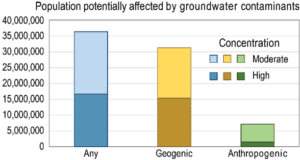New USGS Paper on U.S. Public Supply Well Groundwater Quality
 The U.S. Geological Survey (USGS) has published a new paper on the quality of groundwater used for public supply in the continental United States. This paper presents a comprehensive study of the quality of untreated groundwater using samples from 1,458 wells distributed across 25 Principal Aquifers that account for 84 percent of the groundwater used for public supply in the U.S.. The samples were analyzed for 502 constituents, of which 374 have either a regulatory or nonregulatory human health benchmark.
The U.S. Geological Survey (USGS) has published a new paper on the quality of groundwater used for public supply in the continental United States. This paper presents a comprehensive study of the quality of untreated groundwater using samples from 1,458 wells distributed across 25 Principal Aquifers that account for 84 percent of the groundwater used for public supply in the U.S.. The samples were analyzed for 502 constituents, of which 374 have either a regulatory or nonregulatory human health benchmark.
The study found that about 40 percent of the groundwater used as a source of public supply in the continental U.S. had elevated concentrations (greater than one-half of a human health benchmark) of one or more chemical constituents.
- Naturally occurring geogenic constituents, derived from rocks and sediment, are more prevalent (based on area) and elevated concentrations potentially affect 31 million people.
- Elevated concentrations of anthropogenic (human-caused) constituents potentially affect about 7 million people.
- Three geogenic constituents – manganese, strontium, and molybdenum – are not regulated under the Safe Drinking Water Act but may potentially affect 18 million people.
The paper concludes that additional attention to manganese, strontium, molybdenum, and other unregulated geogenic constituents may be warranted. For more information, see the publication or contact Ken Belitz of USGS.

